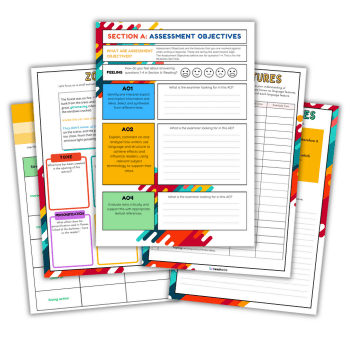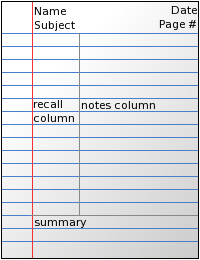Cornell Notes: The revision aid your students never knew they needed

Amy Forrester explains why the Cornell Notes system is just the thing for boosting your pupils’ revision and retention skills…

Under Ofsted’s new inspection framework, schools will now be inspected on the learning behaviours that students display and their awareness of ‘how to study effectively’.
Whilst embarking on something new for Ofsted alone isn’t always wise, focusing on students’ familiarity with learning concepts is a sensible goal. And a key strategy that students can be taught in this area – one that’s applicable across the curriculum – is Cornell Notes.
Cornell Notes is a simple, but powerful way for students to learn the all-important skill of effective note-taking. It provides a clear structure for note-taking which we, as seasoned subject experts, may take for granted. Students are novices, and we need to explicitly teach them strategies that will help them strengthen their study skills.
How does it work?
The structure of Cornell Notes involves organising pages into four distinct sections: a title at the top; a main panel to the right for making notes on the subject in question; a narrower question column to the left for key questions that arise from the learning; and a section at the bottom for a summary to prompt recall of what’s been learned, as shown below.

When introducing this strategy to students it’s vital to start with these four sections, as they need to understand the different foci of each one.
A typical lesson outline might go as follows:
Step 1: introduce the concept of Cornell Notes.
Step 2: Divide your page up into the sections and have the students do the same.
Step 3: Explain the ‘title’ part of the page, and model how to write a title that will be helpful for future study or revision. The key to doing this well is to identify the topic as specifically as possible – for example, ‘Context: Dickens’ views on society’.
Step 4: Move on to the ‘main notes’ section. It’s useful at this stage to have hardcopies of some core knowledge you have recently taught the class. Using these, make use of the ‘I do, we do, you do’ modelling strategy to help students see how to do it and gain confidence, while moving them towards taking notes independently. You may find you need to be very clear in your explanations of how to take notes – making your thinking process explicit will give your students a valuable insight into the processes involved.
Step 5: Now move to the ‘questions’ in the left-hand pane. Before writing anything, explore the purpose that this section serves with the students. Put simply, it provides them with a future revision aid so that when the time comes to check their knowledge, they can simply cover the notes and try to answer the questions. It’s therefore important at this point to show students how to write good recall questions – the ‘I do, we do, you do’ method will again be helpful here, but it can be a tricky part of the process, and it may take some time until the students are able to generate questions confidently.
Step 6: The final stage involves focusing on the ‘summary’ section at the bottom of the page. This is intended to serve as a current study aid, helping them process the knowledge they have learnt while highlighting core learning for future revision. This part can also be hard at first – teaching students how write their summaries succinctly will take some deliberate practice. Long-term retention Once students have mastered the Cornell Notes strategy, the next stage for you, as their teacher, is to build it into your classroom routines and expectations.
Sticking to one coherent strategy will ensure that students have an excellent back catalogue of revision notes for the future. It will also enable you to set high impact, low workload homework, such as self- quizzing from the question prompts, or total recall of notes followed by self- checking in a different coloured pen. These types of tasks will contribute to ensuring that students are focussed on long-term retention of knowledge.
A concern some teachers have over teaching strategies like Cornell Notes is that doing so takes up lesson time that could be spent actually teaching the subject. In fact, the opposite is true. Whilst it may initially feel slightly distanced from the teaching of core subject content, in the longer term the Cornell Notes strategy will help to strengthen students’ ability to study and revise that content. Having a strategy in place that underpins your students’ long-term learning will ultimately pay dividends. As a teacher, it’s more than worth setting aside the time needed upfront to ensure that your students are as well prepared for their future learning as possible.
Tips for getting started
1. Plan its introduction The Cornell Notes system is often best introduced when covering a knowledge-heavy aspect of your subject. In English literature, for example, the teaching of a text’s contextual information presents the perfect opportunity to get started.
2. Prepare the ground Ensure that students possess some prior understanding of recall and retention or self-quizzing – this will help them better understand the purpose of the left-hand column.
3. Use a visualiser It’s much easier to live model the use of the strategy if you can; if it’s not possible for you to use a visualisr, live model the process using your whiteboard, or prepare some notes in advance and take photos that you can display on the main class screen that show the different steps.
4. Explain the system using the system Why not provide your students with an accurate record of what Cornell Notes are and how to use them via the system itself? Slightly meta it may be, but this will give your students a helpful prompt and aid when they start using the system independently.
5. Research other explanations There are plenty of informative YouTube videos out there that can help strengthen your explanation of Cornell Notes and provide you with a good visual accompaniment.
6. Produce multiple guide copies If there’s a chance that your class may spend too long on devising the layout of their notes, make sure you have a bulk supply of copied Cornell Notes pages to hand within the classroom.
Amy Forrester is an English teacher and head of year at Cockermouth School, Cumbria; she tweets as @amymayforrester, where she regularly shares resources using the hashtag #TeamEnglish











